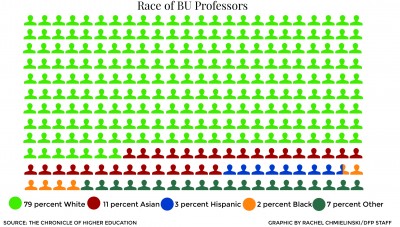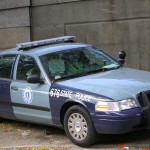
Throughout the 2013-14 academic year, 79 percent of male and female professors of all ranks with or without tenure at Boston University were white, according to an interactive data map published Sunday in the Chronicle of Higher Education.
Eleven percent of BU’s 1,833 professors are Asian, 3 percent are Hispanic and 2 percent are black, the report stated. Compared to similar research universities, the population of white professors at BU is 6 percent higher and 2 percent lower than the population of black professors.
Stephen Brady, co-chair of the Diversity and Inclusion Task Force and psychiatry professor at the BU School of Medicine, said although he cannot verify the numbers provided, they most likely came from self-reported data on behalf of the professors.
“[The data] may not include the number of international professors we have that do not necessarily have a green card … and some [professors] choose not to report,” Brady said.
The task force met with students and faculty from all the BU colleges to discuss the issue of professor diversity through a number of gatherings, Brady said. It has also been conversing with diversity officers and programs across the United States.
The task force ultimately hopes to “consider new approaches to faculty recruitment and retention and the fostering of a more inclusive community,” according to the mission statement from its website.
Among other high-activity research public and private universities, the University of Michigan at Ann Arbor, the University of Pittsburgh main campus and The Ohio State University rank first with 2,673 white professors out of 3,707, second with 2,633 professors out of 3,568 and third with 2,510 professors out of 3,491, respectively. Data presented in the interactive map in was taken from the U.S. Department of Education’s Integrated Postsecondary Education Data System.
Marléna Rose, director of the Boston Education Justice Alliance, wrote in an email that a lack of diversity in school systems could cause members of minority groups to feel left out.
“A lack of representation in the staff and faculty at a center of education can negatively affect student and campus life,” Rose wrote. “Minority students may feel underrepresented, and … issues specific to their group will not receive as much attention or care.”
Rose claimed that for change to be serious and lasting, it must be taken at every level, including forming review boards to monitor faculty and student diversity. Being honest with the students and staff about this issue is also necessary.
“Nothing will change overnight, as lack of diversity is the result of centuries of inequality, but it is possible to achieve, with the help of faculty, staff, and students,” Rose wrote.
BEJA works toward building a stronger and better public school system that is driven by consensus, according to the group’s website.
Bonnie Costello, an English professor in the College of Arts and Sciences, said she was surprised at BU’s percentages. There are similar problems in universities across the nations, she said, but there have been definite attempts at solving them.
“Young people look for role models and evidence that there is a path in the world for them, “ Costello said. “I hope and believe that the university is a place where ideas belong to everyone.”
Several students said they were aware of the lack of diversity on campus but were still surprised by how the numbers reflected the actual difference.
Yadira Flores, a sophomore in CAS, said she didn’t notice the ratio of white professors to minority professors.
“Until learning about this figure, I had not noticed the lack of diversity,” she said. “But looking back, I’ve never had a black or Latino professor. It’s worrisome, but I think the creation of the task force is a good start on the long path to better inclusion.”
Jamie Ferguson, a freshman in the School of Education, said she knows BU has had issues with diversity in the past.
“There have always been problems with diversity here at BU, but the actual statistics on it make me more aware of it,” she said. “It’s important that we have a faculty that reflects and represents the diversity among the student body at BU.”
Belle Widdows, a freshman in CAS, said she hopes this data will encourage change to diversify the BU community.
“As an international student from Thailand, I definitely notice the lack of diversity, but I never thought the number was that high,” she said. “The school can make changes, though, and … any change will have a positive effect on the student body.”





Why bother hiring staff based on their skills and merit rather than what’s really important: the color of their skin?
Very true